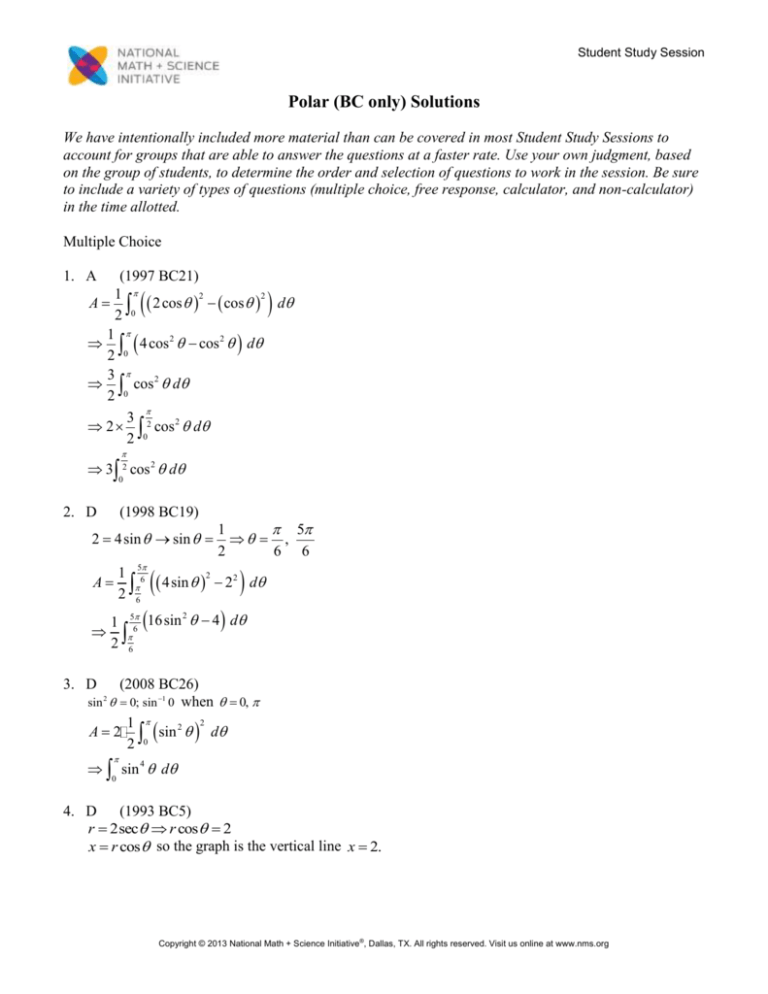
Student Study Session
Polar (BC only) Solutions
We have intentionally included more material than can be covered in most Student Study Sessions to
account for groups that are able to answer the questions at a faster rate. Use your own judgment, based
on the group of students, to determine the order and selection of questions to work in the session. Be sure
to include a variety of types of questions (multiple choice, free response, calculator, and non-calculator)
in the time allotted.
Multiple Choice
1. A
(1997 BC21)
1
2
2
A 2 cos cos d
2 0
1
4 cos 2 cos 2 d
2 0
3
cos 2 d
2 0
3 2
2 cos 2 d
2 0
3 2 cos 2 d
0
2. D
(1998 BC19)
2 4sin sin
1
5
,
2
6 6
1 56
A
2 6
22 d
4sin
2
2
1 56 16sin 4 d
2 6
3. D
(2008 BC26)
when 0,
2
1
A 2 sin 2 d
2 0
sin 2 0; sin 1 0
sin 4 d
0
4. D
(1993 BC5)
r 2sec r cos 2
x r cos so the graph is the vertical line x 2.
Copyright © 2013 National Math + Science Initiative®, Dallas, TX. All rights reserved. Visit us online at www.nms.org
Polar (BC only)
Student Study Session
5. E
(1988 BC23)
r 0 when cos3 0
6
The region is for the interval from
Area
to .
6
6
1 6
2
4 cos 3 d
2 6
6. D
(1985 BC24)
1
Area 2 sin 2 2 d
2 0
1 1
2 1 cos 4 d
2 0 2
1
1
2
sin 4
8
4
4
0
Free Response
7. 2003 BC3
5
3
(a) At P, y 1 y 2 , so y .
3
4
5
5
Since x y , x .
3
4
1: coordinates of P
2
dx
1:
at P
dy
3
dx
3
dx
y
y
4 .
. At P,
2
dy
x
dy 5
5
1 y
4
(c) x r cos ; y r sin
x y 1 r cos r sin 1
1
r2
2
cos sin 2
2
2
2
2
2
2
(d) Let be the angle that segment OP makes
3
y
3
with the x-axis. Then tan 4 .
5
x
5
4
tan 1 3 1
5
r 2 d
Area
0
2
1 tan 1 3 5
1
d
2
0
2
cos sin 2
1: substitutes x r cos and
y r sin into x 2 y 2 1
2
1: isolates r 2
2 1: limits
1: integrand and constant
Copyright © 2013 National Math + Science Initiative®, Dallas, TX. All rights reserved. Visit us online at www.nms.org
Polar (BC only)
Student Study Session
8. 2005 BC2
1
(a) Area r 2 d
2 0
2
1
sin 2 d 4.382
2 0
1: limits and constant
3 1 integrand
1: answer
(b) 2 r cos sin 2 cos
2.786
dr
2
0 for
, r is
d
3
3
decreasing on this interval. This means the
curve is getting closer to the origin.
(c) Since
dr
0
(d) The only value in 0, where
d
2
3
2
1: equation
1: answer
2
1: information about r
1: information about the curve
1:
2
is .
3
r
0
2
or 1.047
3
1: answer with justification
0
1.913
1.571
The greatest distance occurs when
.
3
Copyright © 2013 National Math + Science Initiative®, Dallas, TX. All rights reserved. Visit us online at www.nms.org
Polar (BC only)
Student Study Session
9. 2007 BC3
2
3
(a) Area 2
2
10.370
(b)
dr
dr
dt 3 d
1 4 3
2
3 2cos d
2
3
2
1.732
3
1: area of a circular
sector
2: integral for section
of limacon
4
1: integrand
1: limits and
constant
1: answer
2
1:
dr
dt 3
1: interpretation
dr
0
The particle is moving closer to the origin, since
dt
and r 0 when
(c)
3
.
y r sin 3 2cos sin
dy
dy
dt 3 d
0.5
3
dy
0 and
The particle is moving away from the x-axis, since
dt
y 0 when
3
1: expression for y in
terms of
3 1: dy
dt 3
1: interpretation
.
Copyright © 2013 National Math + Science Initiative®, Dallas, TX. All rights reserved. Visit us online at www.nms.org









